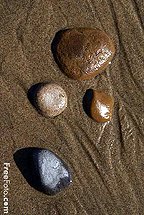History of Mathematics
The documented history of mathematics span over 70'000 years. Mathematics started off probably trying to use and make sense of time.
But mathematics as we know it today begun probably about 3500 years ago along the river Nile in Egypt (numerical hieroglyphes) for very practical, empirical reasons. Dealing with money, commercial issues and measurements.
It then spread or developed on its own along the two rivers of Mesopotamia. And the again along another river in China and India before being incorporated into the Greek world, and then "passed on" and expanded in "Arab" (Muslim Empire) and then Europeans hands (Renaissance).Not to mention The Mayan and Inca's autonomous developments.
So, rivers - carrying water, the source of life, transport and communication - were indeed the catalysators of human civilizations...
 Now, are we perhaps wrong to say that our modern mathematics is thanks to water? That our Mathematical wisdom is the result of those past Egyptian, Mesopotanian, Greek, Indian, Iranian, Chinese,discoveries and findings which were then (re-) discovered and elaborated during the European Renaissance period? Now, are we perhaps wrong to say that our modern mathematics is thanks to water? That our Mathematical wisdom is the result of those past Egyptian, Mesopotanian, Greek, Indian, Iranian, Chinese,discoveries and findings which were then (re-) discovered and elaborated during the European Renaissance period?
And It's probably a fact that many identical mathematical findings were actually found independently in many parts of the world and in different times. So, it's litteraly true to say that we stand today on the shoulders of giants.
Indeed, we cannot stress enough the fact that the scientific and cultural knowledge of humankind is in general a common effort (people learning on other's people's work) ...with some sudden boost of innovation, real geniuses like Archimedes, Thales, Napier, Galileo, Gauss, Euler, Newton and others who deserve a special mention. But also lesser known ones like Diophantus, Aryabhata, Inventor of the Zero, Fibonacci, Tartaglia, Cardano, Pascal, and others....
Instead of now venturing in long explanations of the history of mathematics, it is perhaps useful to sum up some important key discoveries with the help of two mathematic pedagogists [1] and some modifications of my own.
Numbers
Our current way of writing numbers was born in India, then borrowed by Greek and Persian scholars. They were adopted in Europe after the 9th century A.D. In Italy they were opted for in the 13th Century only. Calculations were previously done with Roman Numbers (which is NOT a more difficult way of "doing the math" as some say; the Romans could make sophisticated architectural buildings and engineering works by just using "their" numbers and a few tools).
Positional System
To use positional digits to express units and its multiples instead of just using sticks or dots was originally invented in Mesopotamia ( in Asia between the Tigris and Euphrates rivers), then improved by the Indians and Iranians. It was also an original (independent?) idea of the Mayas.
Zero
Zero had to do with mystic and was introduced first in India in the 6th Century AD. It was also known by the Maya (it had the shape of a shell and called "navel"). In Europe it was not accepted for a long time.
Time and Angles
Nobody studying the history of mathematics knows for sure why the sexagesimal (base 60) system (e.g. round angle = 360 degree; 1 minute = 60 seconds) was invented but probably is because the year has approximately 360 days. It was originally an Assirian (North Mesopotamia, an area comprised in today's parts of Iran, Turkey, Iraq and Syria) invention.Then it was enhanced by the Baylonians and Sumers.
Algorithms
Before the Renaissance, in Europe people were using abaci with little pebbles (these pebbles were called "calculi" in old Italian, from were "calculus" comes from) of Roman origin. Algorithms came from India and Persia but were not accepted immediately, despite their usefulness (at least as we see it today; remind one major thing: we cannot judge the past with our modern eyes. We must try to understand the contemporary mind).
Area and Volumes
The Egyptians and Sumers had sophisticated calculations for plane and solid geometries. They could calculate difficult areas and volumes. Basic geometrical ideas were found on rock painting in a South African cavern dating 70'000 years ago.
Circumference and diagonal
The calculation of the circumference given the diameter, and of the diagonal of a square given the side were again Sumer and Egyptians discoveries then assimilated in the Greek civilization.
Pythagorean Theorem
The so called pythagorean theorem (6th-5th century BC) is already described in the Rhind Papyr written by the scribe Ahmes about in 1650 BC (itself a copy of another, a few centuries older papyr). The Rhind papyr is today at the British Museum of London. The pythagorean triads were also probably present in some previous magalithic Egyptians (4-5000 BC) and English and Scottish (3-2000 BC) momuments.
Pi  in the history of mathematics in the history of mathematics
A notion of Pi (the universal constant number which relates the circumference of any circle with its diameter) was known in India (North and Pakistan, 3000-2600 AD) and in Egypt (Rhind Papyr, 1650 BC).
Prime numbers
Again in the Egyptian Rhind papyr along with the concepts of arithmetic mean, geometric mean and harmonic mean.
The Negative Numbers
They were invented in India in the 5th-6th century AD, then taken by the "arab" world and then reached Europe in the 9th century AD but were fully accepted only at the end of 15th Century AD. In Europe they were looked down for a long time and called "absurd" ("surdi" in Italian) numbers.
Fractions
The Egyptians had a love relation with fractions which were used extensively. They expressed rational numbers with sums of fractions with numerator 1 or with the fraction 2/3.
Binary mathematics
The history of mathematics tell us that In central and South America there is ancient evidence of this system of counting with base 2. In today's Ecuatorian Amazonas there are people still using bynary aritmetics.
Logic in history of mathematics
Next to the rigorous Aristotelan logic there are other logics such as the hindu logic called nyanya, today nearly completely forgotten. But D'Amore [3] points out that some "week" students were unawarely using this kind of logic
From History of Mathematics back to the homepage
Sources:
1. D'Amore B., Fandiño Pinilla M.I. (2005), "Storia ed epistemologia della matematica, basi etiche". La matematica e la sua didattica 4, 5003-515.
2. http://it.wikipedia.org/wiki/Storia_della_matematica (Italian; made by a 15 years old guy, Guido Giachetti, near Florence; stand December 2009)
3. D'Amore B. (2002), "Matematica in alcune culture sudamericane. Un contributo all'etnomatematica." Bollettino dei docenti di matematica (Bellinzona, Svizzera), 44, 39.46.
Further sources:
http://fr.wikipedia.org/wiki/Histoire_des_math%C3%A9matiques
http://www.chronomath.com/ (French)
|


 Now, are we perhaps wrong to say that our modern mathematics is thanks to water? That our Mathematical wisdom is the result of those past Egyptian, Mesopotanian, Greek, Indian, Iranian, Chinese,discoveries and findings which were then (re-) discovered and elaborated during the European Renaissance period?
Now, are we perhaps wrong to say that our modern mathematics is thanks to water? That our Mathematical wisdom is the result of those past Egyptian, Mesopotanian, Greek, Indian, Iranian, Chinese,discoveries and findings which were then (re-) discovered and elaborated during the European Renaissance period?